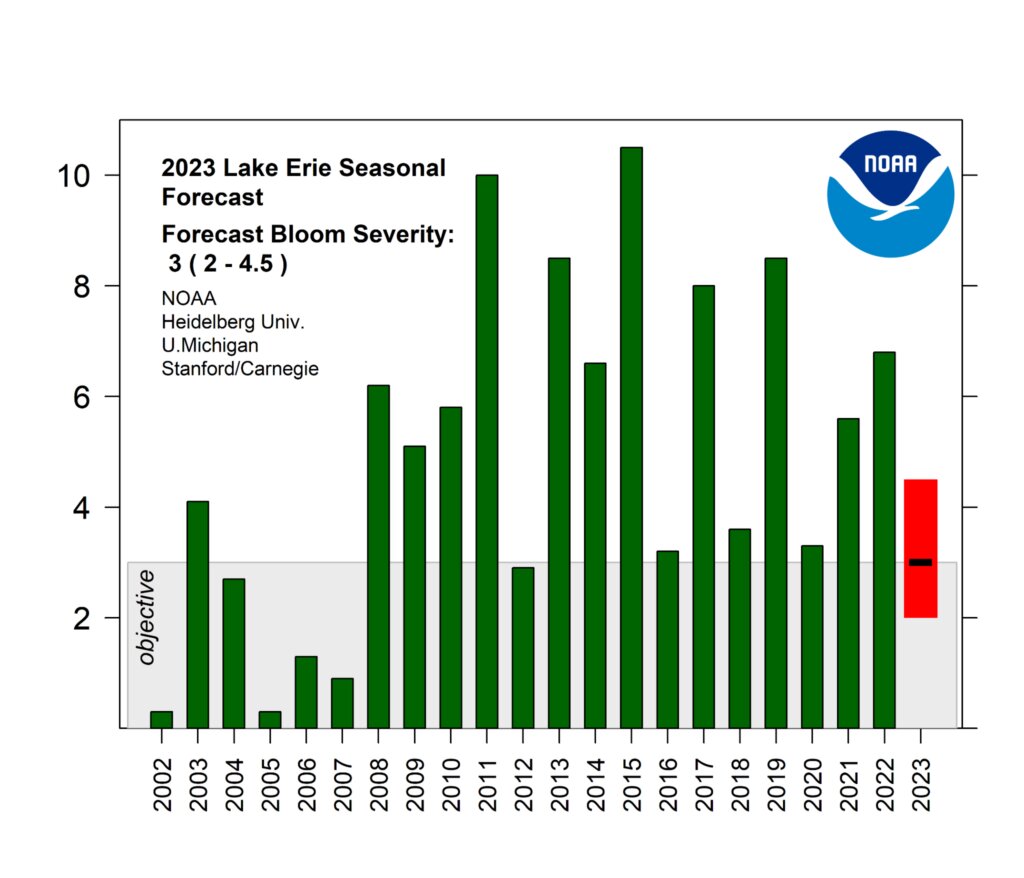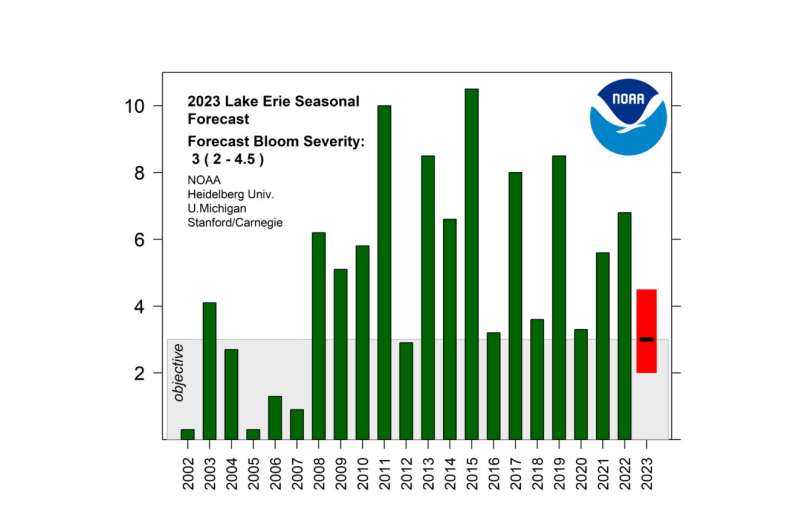

NOAA and its research partners, including the University of Michigan, are forecasting that western Lake Erie will experience a smaller-than-average harmful algal bloom this summer, which would make it less severe than 2022.
This year’s bloom is expected to measure 3, with a potential range of 2-4.5 on the severity index, whereas last year’s bloom was measured at a 6.8, the National Oceanic and Atmospheric Administration announced today.
The index is based on the bloom’s biomass—the amount of algae—during the peak 30 days of the bloom. An index above 5 indicates more severe blooms. Blooms over 7 are particularly severe, with extensive scum formation and coverage affecting the lake. The largest blooms occurred in 2011, with a severity index of 10; and 2015, with a severity index of 10.5.
“While this year’s forecast is smaller than the long-term average, it was driven primarily by the lowest river flows in the past 10 years. We cannot just cross our fingers and hope that drier weather will keep us safe,” said U-M aquatic ecologist Don Scavia, a member of the forecast team.
“These blooms are driven by diffuse phosphorus sources from the agriculturally dominated Maumee River watershed. Until the phosphorus inputs are reduced significantly and consistently so that only the mildest blooms occur, the people, the ecosystem and the economy of this region are being threatened,” said Scavia, professor emeritus at the School for Environment and Sustainability.
Lake Erie harmful algal blooms consisting of cyanobacteria, or blue-green algae, are capable of producing microcystin, a known liver toxin that poses a risk to human and wildlife health. Such blooms may force cities and local governments to treat drinking water and to close beaches, and they can harm vital local economies by preventing people from fishing, swimming, boating and visiting the shoreline.
The size of a bloom isn’t necessarily an indication of how toxic it is. For example, the toxins in a large bloom may not be as concentrated as in a smaller bloom. Each algal bloom is unique in terms of size, toxicity and ultimately its impact on local communities.
“By consistently improving the science behind our forecasts, we’re giving Great Lakes communities the information they need to plan for blooms of varying severity,” said Nicole LeBoeuf, director of NOAA’s National Ocean Service. “Understanding and addressing hazards such as harmful algal blooms can help us ensure that the Great Lakes are an engine of the blue econom”
NOAA’s National Centers for Coastal Ocean Science’s Lake Erie HAB Forecast website provides predictions and visualizations of the bloom’s location and movement on the lake’s surface as well as where the bloom is located within the water column. This information is especially helpful to water treatment plant operators, because intake structures are usually located below the surface, so the risk of toxins in their source water may be greater when these cells sink.
“NCCOS’s Lake Erie HAB Forecast continues to be a valuable resource for Lake Erie residents, visitors, and the state,” said Christopher Winslow, director of Ohio Sea Grant and Ohio State University’s Stone Laboratory. “This NOAA forecast, and the research being conducted by academic institutions and both state and federal agencies to understand blooms and nutrient runoff, will continue to guide efforts to address these summer bloom events.”
NOAA expects a start of the visible bloom in mid-to-late July. The duration of the bloom depends on the frequency of wind events in September, which cannot be predicted this far in advance. The bloom will remain mostly in areas of the western basin. The lake’s central and eastern basins are usually unaffected, although localized blooms may occur around some of the rivers after summer rainstorms.
The range in forecasted severity reflects the uncertainty in forecasting precipitation, particularly for late June and July. Larger rain events during the summer could result in increased river flow, and a higher severity index. NOAA will issue a seasonal forecast update in early August based on observed rainfall in the basin.
“While this spring has been quite dry, the lake received a large nutrient load in March, which will produce at least a mild bloom this summer,” said Richard Stumpf, NCCOS’s lead scientist for the seasonal Lake Erie bloom forecast. “However, like recent years, we have a potential of additional nutrient load in July, which could lead to a moderate bloom.”
The Lake Erie forecast is part of a NOAA Ecological Forecasting initiative, which aims to deliver accurate, relevant, timely and reliable ecological forecasts directly to coastal resource managers, public health officials and the public. In addition to the early season projections from NOAA and its partners, NOAA also issues HABs forecasts during the bloom season. These forecasts provide the current extent and five-day outlooks of where the bloom will travel and what concentrations are likely to be seen, allowing local decision-makers to make informed management decisions.
In addition, NOAA is developing tools to detect and predict how toxic blooms will be.
Nutrient load data for the forecasts came from Heidelberg University in Ohio. The various forecast models are run by NCCOS, the University of Michigan, North Carolina State University, LimnoTech, Stanford University and the Carnegie Institution for Science.
Field observations used for monitoring and modeling are done in partnership with a number of NOAA services, including its Ohio River Forecast Center, NCCOS, the Center for Operational Oceanographic Products and Services, and the Great Lakes Environmental Research Laboratory, as well as the University of Michigan-based Cooperative Institute for Great Lakes Research, Ohio Sea Grant, Stone Laboratory, the University of Toledo, and Ohio EPA.
Provided by
University of Michigan
Citation:
Smaller-than-average harmful algal bloom predicted for western Lake Erie (2023, June 29)
retrieved 30 June 2023
from https://phys.org/news/2023-06-smaller-than-average-algal-bloom-western-lake.html
This document is subject to copyright. Apart from any fair dealing for the purpose of private study or research, no
part may be reproduced without the written permission. The content is provided for information purposes only.